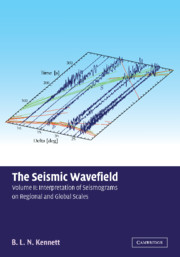Book contents
- Frontmatter
- Contents
- Preface to Volume II
- Part III Local and Regional Events
- Part IV Global Wave Propagation
- 24 The Nature of the Global Wavefield
- 25 Body Waves in the Mantle
- 26 Body Waves and the Earth's Core
- 27 Surface Waves and Modal Analysis
- 28 Receiver Based Studies
- 29 Analysis of Seismic Records
- Part V The Three-dimensional Earth
- Appendix Paths and Travel times
- Bibliography
- Index
26 - Body Waves and the Earth's Core
from Part IV - Global Wave Propagation
Published online by Cambridge University Press: 31 August 2019
- Frontmatter
- Contents
- Preface to Volume II
- Part III Local and Regional Events
- Part IV Global Wave Propagation
- 24 The Nature of the Global Wavefield
- 25 Body Waves in the Mantle
- 26 Body Waves and the Earth's Core
- 27 Surface Waves and Modal Analysis
- 28 Receiver Based Studies
- 29 Analysis of Seismic Records
- Part V The Three-dimensional Earth
- Appendix Paths and Travel times
- Bibliography
- Index
Summary
In the discussion of the nature of global wave propagation in Chapter 24 we have seen the complexity of the wavefront patterns in the Earth's core associated with the many different propagation processes in the core, with internal multiples from the core-mantle boundary, strong refraction of P waves from the gradients in the outer core, and conversions between P and SV at the core-mantle boundary.
In this chapter we will focus first on the major core phases and their multiples. We illustrate the travel time behaviour and the relation to the associated ray patterns through the Earth. The nature of the seismograms will be illustrated with record sections covering the significant distance ranges in different frequency bands.
The seismic velocity structure in the core is constrained by both the properties of the Earth's normal modes and the observations of the travel times of seismic phases. Because the core itself is a low velocity zone for P waves relative to the mantle, but not relative to S in the mantle, direct sampling of the outermost part of the core comes from the SKS phases. There is thus a very close tie between the velocity structures adopted in the mantle and the core.
The inner core can only be studied by the way in which it interacts with different classes of seismic waves and so we are probing with waves that can be influenced by the heterogeneity of the mantle, particularly near the core-mantle boundary. Nevertheless there are indications of anisotropy in seismic properties, and some degree of heterogeneity, in this body at the centre of the Earth.
The strong heterogeneity near the core-mantle boundary has been invoked as one of the causes of scattered waves associated with core phases which are, e.g., prominent as precursors to PKP near 140° epicentral distance.
Representation of core propagation processes
In Chapter I:14 we have made a representation of the propagation processes affecting a seismogram and have shown how we can separate off the influence of the shallow part of the structure, including near-source and near-receiver effects, and concentrate attention on the return from structure at depth.
- Type
- Chapter
- Information
- The Seismic WavefieldVolume II: Interpretation of Seismograms on Regional and Global Scales, pp. 258 - 279Publisher: Cambridge University PressPrint publication year: 2002



